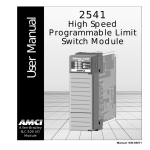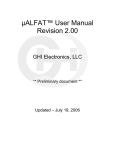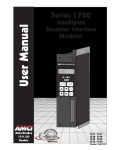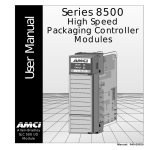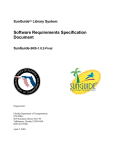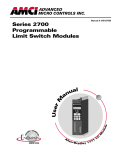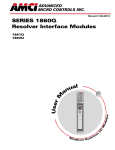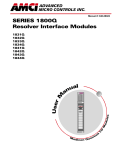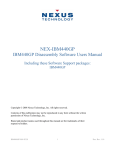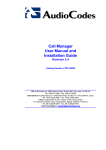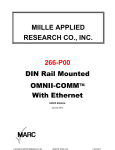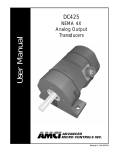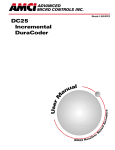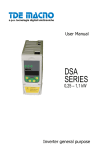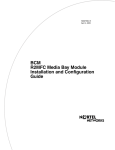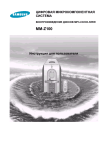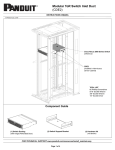Download 1541-03 manual - Advanced Micro Controls Inc
Transcript
User Manual 1541-03 Resolver Input Brake Monitor Module SLC 500 I/O Module Manual: 940-55031 GENERAL INFORMA TION INFORMATION Important User Information The products and application data described in this manual are useful in a wide variety of different applications. Therefore, the user and others responsible for applying these products described herein are responsible for determining the acceptability for each application. While efforts have been made to provide accurate information within this manual, AMCI assumes no responsibility for the application or the completeness of the information contained herein. Throughout this manual the following two notices are used to highlight important points. WARNINGS tell you when people may be hurt or equipment may be damaged if the procedure is not followed properly. CAUTIONS tell you when equipment may be damaged if the procedure is not followed properly. No patent liability is assumed by AMCI, with respect to use of information, circuits, equipment, or software described in this manual. The information contained within this manual is subject to change without notice. UNDER NO CIRCUMSTANCES WILL ADVANCED MICRO CONTROLS, INC. BE RESPONSIBLE OR LIABLE FOR ANY DAMAGES OR LOSSES, INCLUDING INDIRECT OR CONSEQUENTIAL DAMAGES OR LOSSES, ARISING FROM THE USE OF ANY INFORMATION CONTAINED WITHIN THIS MANUAL, OR THE USE OF ANY PRODUCTS OR SERVICES REFERENCED HEREIN. Standard Warranty ADVANCED MICRO CONTROLS, INC. warrants that all equipment manufactured by it will be free from defects, under normal use, in materials and workmanship for a period of [1] year. Within this warranty period, AMCI shall, at its option, repair or replace, free of charge, any equipment covered by this warranty which is returned, shipping charges prepaid, within one year from date of invoice, and which upon examination proves to be defective in material or workmanship and not caused by accident, misuse, neglect, alteration, improper installation or improper testing. The provisions of the “STANDARD WARRANTY” are the sole obligations of AMCI and excludes all other warranties expressed or implied. In no event shall AMCI be liable for incidental or consequential damages or for delay in performance of this warranty. Returns Policy All equipment being returned to AMCI for repair or replacement, regardless of warranty status, must have a Return Merchandise Authorization number issued by AMCI. Call (860) 585-1254 with the model and serial numbers along with a description of the problem. A “RMA” number will be issued. Equipment must be shipped to AMCI with transportation charges prepaid. Title and risk of loss or damage remains with the customer until shipment is received by AMCI. 24 Hour Technical Support Number 24 Hour technical support is available on this product. For technical support, call (860) 583-7271. Your call will be answered by the factory during regular business hours, Monday through Friday, 8AM - 5PM EST. During non-business hours, an automated system will ask you to leave a detailed message and the telephone number that you can be reached at. The system will page one of two engineers on call. Please have your product model number and a description of the problem ready before you call. ADVANCED MICRO CONTROLS INC ABOUT THIS MANUAL Introduction This manual explains the operation, installation, and programming of the 1541-03 Brake Monitor Module for the Allen-Bradley SLC 5001™ programmable controller systems. The first member of AMCI’s ™ line of press control products, the 1541-03 uses a resolver based transducer for stroke position feedback and measures the stopping time of the ram. It does this by measuring the time from the activation of its brake input until the resolver position does not change for 125 milliseconds. The 1541-03 also has remote display capability with AMCI’s 6100/6200 Remote Displays. It is strongly recommended that you read the following instructions. If there are any unanswered questions after reading this manual, call the factory. An applications engineer will be available to assist you. AMCI is a registered trademark of Advanced Micro Controls Inc. The AMCI logo is a trademark of Advanced Micro Controls Inc. PRESSPro is a trademark of Advanced Micro Controls Inc. SLC and SLC 500 are trademarks of Allen-Bradley Company. Adobe and Acrobat are trademarks of Adobe Systems Incorporated. This product incorporates technology which is licensed by Allen-Bradley Company, Inc. AllenBradley has not technically approved, nor does it support this product. All warranty and support for this product and its application is provided solely by Advanced Micro Controls Inc. Manuals at AMCI are constantly evolving entities. Your questions and comments on this manual and the information it contains are both welcomed and necessary if this manual is to be improved. Please direct all comments to: Technical Documentation, AMCI, 20 Gear Drive, Plymouth Industrial Park, Terryville CT 06786, or fax us at (860) 584-1973. Revision Record The following is the revision history for this manual. In addition to the information listed here, revisions will fix any known typographical errors and clarification notes may be added. This manual, 940-55031, is the first release of this PDF manual and is the equivalent to the printed manual 940-05031. It corresponds to software revision 2, checksum B8CD. 20 Gear Drive, Plymouth Ind. Park, Terryville, CT 06786 Tel: (860) 585-1254 Fax: (860) 584-1973 3 ABOUT THIS MANUAL Navigating Through This Manual Bookmarks The table of contents in the printed version of this manual has been entirely replaced with Acrobat™ bookmarks. To access the bookmarks, press the button here, or in the toolbar. The bookmarks will appear in a window to the left of the document. The bookmarks are multilevel, just like the table of contents in the printed version. Click on the arrows ‘w’ next to the bookmarks to expand or contract them. When you see the section you want to go to, click on the bookmark and the manual will jump to the correct page. Thumbnails Thumbnails are small images of each page that you can use to navigate between pages. They are not included in this file because they increase the files’ size by about 10% and the bookmarks are much more useful. Links Two types of links exist in the text: Blue Text: Blue text is a reference to another part of the manual. Clicking on the text will jump you to the reference. The reference is highlighted with a blue star ‘V’. Pressing the star will send you back to the page that made the reference. The green arrow appears at the bottom of a page if there is more information on the following page. For convenience, clicking on the arrow will send you to the next page. 4 ADVANCED MICRO CONTROLS INC 1 INTRODUCTION This chapter serves as an introduction to the 1541-03 module. It highlights potential applications, compatible transducers, and all of the module’s features. Overview Designed specifically for press control applications, the 1541-03 module is a resolver interface module that also includes a brake monitoring feature. This feature measures the time from the activation of an input to the cessation of transducer movement. The input can be the Brake Trigger Bit in the output image table or the opto-isolated Brake Trigger Input on the front panel. A brake cycle is triggered by a transition on the selected input. The Brake Trigger Bit always triggers on a 1Ž0 transition. The transition on the Brake Trigger Input that triggers a brake cycle is programmable. Resolver Data The 1541-03 uses a resolver based transducer for ram position and velocity feedback. Compatible with AMCI and Autotech Controls transducers, position resolution is fully programmable from 2 to 4,096 counts per turn. Two status bits in the input image table are used to tell you when the transducer is in motion and in which direction the transducer is rotating. A programming bit in the output image table allows you to change the direction of rotation that increases the position value without re-wiring the transducer cable. The module calculates tachometer data from the position data. By programming the Tachometer Response parameter, you control how often the tachometer is updated, every 24 or 120 milliseconds. A programmable motion detector sets a bit in the input image table whenever the tachometer value is within your programmed limits. Figure 1.1 1541-03 Module Position Preset The opto-isolated Preset Input on the module is available to preset the transducer position to your pre-programmed value from a remote location. A bit in the input image table tells you when the input is active. The transducer position can also be preset with a bit in the output image table. Because the position and tachometer data is available in the input image table, the 1541-03 can be used to control press functions that are based on ram position. 20 Gear Drive, Plymouth Ind. Park, Terryville, CT 06786 Tel: (860) 585-1254 Fax: (860) 584-1973 5 1 INTRODUCTION Overview (continued) Brake Monitor By default, the Brake Trigger Bit in the output image table triggers a brake cycle. The 1541-03 measures the time between a 1Ž0 transition on this bit and the cessation of transducer motion. When the brake cycle is completed, Stop Time, Brake Applied Position, and Stop Angle data is placed in the input image table. † † † † Stop Time is the stopping time of the press. Its range is 2 milliseconds to 9.999 seconds with a resolution of one millisecond. Brake Applied Position is the position at which the brake trigger was activated. Stop Angle is the angular rotation that the press completed while the brake was applied. You can program its format to be in counts or tenths of a degree. A bit is set when the brake cycle data is valid. It remains set until the next brake cycle is triggered. You can program the 1541-03 to start a brake cycle with the opto-isolated Brake Trigger Input on the front panel instead of the Brake Trigger Bit in the output image table. A brake cycle is triggered when the input makes its programmed transition. This transition is programmed to be either offŽon or onŽoff. The Brake Input State bit in the input image table reports the on/off status of the Brake Trigger Input. Therefore, you can use the Brake Trigger Input as a standard DC input when triggering brake cycles from the backplane. When using the Brake Trigger Input, the state of the Brake Trigger Bit in the output image table is ignored. Remote Display The remote display interface on the 1541-03 allows you to display Position, Tachometer, Stop Time, Brake Position, or Stop Angle data on an AMCI 6100 or 6200 remote display. The data sent to the remote display is determined by programming bits that you write to the output image table. In addition to all the features listed above, the module also includes an extensive set of module and transducer fault diagnostics. Stop Time Monitoring The stop time monitor of the 1541-03 module measures the time between the activation of either the Brake Trigger Bit or Brake Trigger Input, and the stopping of the transducer’s shaft. The Stop Time Timer measures a stopping time of 2 milliseconds to 9.999 seconds when using the Brake Trigger Bit or 26 milliseconds to 9.999 seconds when using the Brake Trigger Input. In either case, the resolution of the Stop Time is one millisecond. The 1541-03 also captures the position at which the brake was applied, and calculates the angle of rotation made by the transducer while braking. These three data words are placed in the input image table and can be displayed on an AMCI remote display. The stop time monitor is a monitoring feature only. Any determination of the correct operation of the press brake must be made by the SLC processor through a user developed ladder logic program. 6 ADVANCED MICRO CONTROLS INC 1 INTRODUCTION Stop Time Monitoring (continued) Figure 1.2 shows how the stop time is measured. The term ‘brake trigger’ refers to either the Brake Trigger Bit or the Brake Trigger Input, depending on how the module is setup. À Á Input State is 'Don't Care' from the end of the Debounce Time until press has stopped. Â Brake 1 Input 0 Debounce Time Brake Trigger Bit = 0 mS Brake Trigger Input = 25 mSec ∆Position Measured Stop Time Brake Applied Position ∆P=0 Figure 1.2 Stop Time Measurement À The module captures the Brake Applied Position and starts the Stop Time Timer when the brake trigger first transitions. (1Ž0 for the Brake Trigger Bit or the programmed transition for the Brake Trigger Input.) The Brake Applied Position is not immediately placed in the input image table. It is updated, along with the Stop Time and Stop Angle, when the brake cycle is complete. If the Brake Trigger Input is used, it is debounced for twenty-five milliseconds. The Brake Trigger Bit is not debounced, but acted upon immediately. 1) If the Brake Trigger Input returns to its normal state for eight milliseconds in the next twenty-five, the input transition is considered noise and the brake cycle is aborted. The next transition on the Brake Trigger Input will start the brake cycle again. 2) If the Brake Trigger Input is not in its active state for the last eight milliseconds of the twenty-five millisecond debounce time, the input transition is considered noise and the brake cycle is aborted. If the input is in its active state at the end of the twenty-five milliseconds, the brake cycle will begin again immediately. If the input is in its normal state, the brake cycle will start on the next transition. Á Â Once the debounce time is exceeded, the state of the brake trigger is ignored until the brake cycle is complete. From this point on, the Stop Time timer runs until the transducer position stops changing. The ‘∆Position’ section of the diagram shows the press coming to a stop. The Stop Time timer stops when the change in position value equals zero. The transducer is considered stopped when there is less than 1/2,048th of a rotation made in 125 milliseconds. This translates into less than one turn every 4.2 minutes. Obviously, it takes 125 milliseconds to determine that the position has not changed for that amount of time. Therefore, the Stop Time timer runs until the transducer does not move for 125 milliseconds, and then subtracts the 125 milliseconds from the Stop Time value. 20 Gear Drive, Plymouth Ind. Park, Terryville, CT 06786 Tel: (860) 585-1254 Fax: (860) 584-1973 7 1 INTRODUCTION AMCI Compatible Transducers Table 1.1 lists the AMCI transducers that are compatible with the 1541-03 module. Model Shaft Mount Turns Comments R11X-J10/7 R11X-J12/7 0.120" 0.188 HT-6 0.188" HT-20 0.625" HT-20S 0.625" HT-20K 0.625" HT-20L 0.625" HT-20C 0.625" H25FE H25FS H25FL-(x) H25SE H25SS H25SL-(x) HTT-20-1 0.375" 0.375" 0.375" 0.375" 0.375" 0.375" 0.625" Servo Servo Front or Side Front or Side Front or Side Front or Side Front or Side Front or Side Flange Flange Flange Servo Servo Servo Front 1 1 NEMA 1, Size 11 Resolver NEMA 1, Size 11 Resolver 1 NEMA 13, R11X-J12/7 transducer 1 NEMA 13, Heavy duty transducer 1 HT-20 w/ side connector 1 NEMA 4X HT-20 w/ Viton shaft seal 1 NEMA 4X HT-20 w/ Nitrile shaft seal 1 1 1 1 1 1 1 1 NEMA 4X stainless steel HT-20, Viton seal, conduit connector NEMA 4, size 25, end connector NEMA 4, size 25, side connector NEMA 4, size 25, integral cable of (x) feet. NEMA 4, size 25, end connector NEMA 4, size 25, side connector NEMA 4, size 25, integral cable of (x) feet. Redundant single turn resolvers† † This package contains two resolvers geared 1:1 with the input shaft. Most commonly used in systems that mandate redundant sensors, AMCI can install two different size 11 resolvers in the package per customer requirements. Contact AMCI for more information. Table 1.1 Compatible AMCI Transducers Other Compatible Transducers In addition to AMCI transducers, the 1541-03 directly supports Autotech Controls transducers. The Autotech models supported are: † † † All SAC-RL100 Transducers. (Size 40, NEMA 13) All E6R and E7R-RL101 Transducers. (Size 25, NEMA 13) SAC-RL101-010 Transducer. (Size 11, NEMA 1) You select between AMCI and Autotech transducers through backplane programming. The module then sets the reference voltage for the resolver according to your selection. 8 ADVANCED MICRO CONTROLS INC INTRODUCTION 1 The remainder of this chapter introduces the many programmable features of the 1541-03 brake monitor module. It also introduces backplane programming concepts that allows you to use the programmable features to configure the module for your application. Programmable Parameters A 1541-03 brake monitor module is configured by setting its programmable parameters. Parameters are broken into two groups. † Transducer Setup Parameters - Four parameters that affect the position and tachometer data of the transducer. † Module Setup Parameters - Eight parameters that set the type of resolver attached to the module, how transducer faults are responded to, how the brake and preset inputs are configured, and limits on the motion detector. Programmable parameters are stored in the modules nonvolatile memory. Therefore, you do not have to configure the module after every power up. The nonvolatile memory is EEPROM memory that is rated for approximately 100,000 write cycles. Transducer Setup Parameters Scale Factor The Scale Factor sets the number of counts per turn of the resolver. † † The default Scale Factor is 360. This gives 1 degree resolution. The Scale Factor can be programmed to any value between 2 and 4,096. Preset Value The Preset Value parameter allows you to set the value of the position count to any value within its range. Programming the Preset Value does not changes the position data, it only sets the value that the position will change to when a Preset Command is initiated. † † † The default Preset Value is zero. The Preset Value can be programmed to any value from zero to (Scale Factor – 1). Programming the Scale Factor resets the Preset Value to zero. Count Direction This parameter sets the direction of transducer shaft rotation that increases the position count. If the transducer is wired as specified in this manual and the count direction is set to positive, the count will increase with clockwise rotation, (looking at the shaft). If the count direction is set to negative, the position count will increase with counter-clockwise rotation. † The default Count Direction value is positive. 20 Gear Drive, Plymouth Ind. Park, Terryville, CT 06786 Tel: (860) 585-1254 Fax: (860) 584-1973 9 1 INTRODUCTION Transducer Setup Parameters (continued) Tachometer Response This parameter sets the time between tachometer updates. The tachometer has a resolution of 1.0 RPM and a maximum speed of 5,000 RPM. † The default value is 120 milliseconds between tachometer updates. The value can be set to 120 or 24 milliseconds. The 24 millisecond setting offers quicker response to changes in transducer speed while the 120 millisecond setting offers better averaging. Module Setup Parameters Resolver Type The Resolver Type parameter makes most Autotech transducers compatible with the 1541-03 module. This is accomplished by adjusting the modules’ reference voltage when Autotech resolvers are selected with this parameter. † The default Resolver Type value is AMCI. Transducer Fault Latch Normally, a transducer fault is latched by the module and can only be cleared by sending a Clear Errors command over the backplane. You can disable the latch with this parameter. Once disabled, a transducer fault will clear itself as soon as a working transducer is properly attached to the module. † The default value for the Transducer Fault Latch is enabled. The transducer fault latch is enabled by default because the module can detect and clear a transducer fault at a rate much faster than the SLC scan time. Therefore, latching the transducer fault guarantees that the processor will see a fault if it occurs. Preset Input Transition This parameter defines which transition on the front panel’s Preset Input, offŽon or onŽoff, presets the position count. † † The default value of the Preset Input Transition parameter is Transition Off. The range of values for this parameter is Transition Off or Transition On. ‘Transition Off’ refers to the transition from current flowing through the input to no current flow, (onŽoff). ‘Transition On’ refers to the transition from no current flow, to full current flow through the input, (offŽon). The terms ‘Transition Off’ and ‘Transition On’ are used instead of references to how power is applied to the Preset Input because the Preset Input can be wired either as a sinking or as a sourcing input. When wired as a sinking input, applying the proper voltage will activate the input. When wired as a sourcing input, connecting the input to ground will activate the input. This parameter applies to the front panel’s Preset Input only. A 0Ž1 transition on the Preset Position Bit in the output image table will always preset the position. You cannot program the module to preset the position on a 1Ž0 transition of the Preset Position Bit in the output image table. 10 ADVANCED MICRO CONTROLS INC INTRODUCTION 1 Module Setup Parameters (continued) Preset Input Debounce This parameter defines how long the front panel’s Preset Input must be in its active state before the preset occurs. † The default value of the Preset Input Debounce parameter is 0 milliseconds. (No debounce.) The Preset Input Debounce parameter can be programmed to 0, 0.5, 1, 2, 4, 8, 16, 32, or 64 milliseconds. This parameter only applies to the Preset Input on the 1541-03’s front panel. The Preset Position bit in the output image table is not debounced. Motion Detector ON/OFF Limits These two parameters define the speed range that the Motion Detector bit in the input image table is set. † † The default value for the Motion Detector Limits is zero. (Motion Detector bit is always off.) The range of values for both limits is 0 to 32,767. When the ON limit is less than the OFF limit, the motion detector bit is set when the tachometer value is between the two limits. When the ON limit is greater than the OFF limit, the motion detector bit is set when the tachometer value is outside the range of the limits and reset when inside the range. Brake Trigger Control There are two inputs that can trigger a brake cycle. The first is the Brake Trigger Bit in the output image table. The second is the Brake Trigger Input on the front panel. This parameter determines which input triggers a brake cycle. † † The default value of the Brake Trigger Control parameter is Backplane. The two available choices for this parameter are Backplane and Front Panel. When configured for Backplane, a 1Ž0 transition on the Brake Trigger Bit in the output image table will start the brake cycle. When configured for Front Panel, the transition on the Brake Trigger Input that triggers a brake cycle is programmable with the Brake Input Transition parameter. Brake Input Transition This parameter defines which transition on the Brake Trigger Input, offŽon or onŽoff, triggers a brake cycle when the Brake Trigger Input is enabled. † † The default value of the Brake Input Transition parameter is Transition On. The range of values for this parameter is Transition On or Transition Off. ‘Transition On’ refers to the transition from no current flow to full current flow through the input, (offŽon). ‘Transition Off’ refers to the transition from current flowing through the input to no current flow, (onŽoff). The terms ‘Transition On’ and ‘Transition Off’ are used instead of references to how power is applied to the input because the Brake Trigger Input can be wired either as a sinking or as a sourcing input. When wired as a sinking input, applying the proper voltage will activate the input. When wired as a sourcing input, connecting the input to ground will activate the input. 20 Gear Drive, Plymouth Ind. Park, Terryville, CT 06786 Tel: (860) 585-1254 Fax: (860) 584-1973 11 1 INTRODUCTION Module Setup Parameters (continued) Brake Input Transition (continued) This parameter applies to the Brake Trigger Input on the front panel only. The Brake Trigger Bit in the output image table will only trigger a brake cycle on a 1Ž0 transition when the bit is enabled. You cannot program the module to trigger a brake cycle on a 0Ž1 transition of the Brake Trigger Bit. Brake Angle Scaling This parameters defines the engineering units of the Brake Angle data. † † The default value of the Brake Angle Scaling parameter is Counts. The range of values for the Brake Angle Scaling parameter is Counts or 0.1°. When set to Counts, the Brake Angle is reported in the same units as the position value, which is determined by the Scale Factor parameter. When set to 0.1°, the Brake Angle is reported in tenths of a degree, (45 degrees is reported as 450), regardless of the Scale Factor value. Remote Display Data This parameter allows you to change the data sent to an AMCI 6100 or 6200 remote display. † † The default value of the Remote Display Data parameter is Position. The range of values for the Remote Display Data Parameter is Position, Tachometer, Stop Time, or Brake Angle. When the Brake Angle Scaling parameter is set to 0.1°, the AMCI remote display will show a decimal point in the Brake Angle data. Backplane Programming A 1541-03 module is programmed by writing data to it through the output image table. Changes to the Brake Trigger Bit and Remote Display Data bits are acted upon immediately by the module. All other control bits and parameter values are not acted upon until you initiate a Programming Cycle in your ladder logic. Programming Cycle A Programming cycle consists of six steps and is controlled by the Transmit Bit in the output image table and the Acknowledge Bit in the input image table. 1) Write the new programming data into the output image table with the Transmit Bit reset. This step insures that the correct data is in the output image table before the Programming Cycle begins. 2) Set the Transmit bit. A Programming Cycle is initiated when this bit makes a 0Ž1 transition. 3) Once the 1541-03 is done with the programming data it will set any necessary error bits and the Acknowledge Bit in the input image table. 4) Once you see that the Acknowledge Bit is set, check for any errors. The error bits are only valid when the Acknowledge Bit is set. 5) Respond to any errors and reset the Transmit Bit by writing 0000h in output word zero. 6) The module responds by resetting the Acknowledge Bit. The Programming Cycle is complete. 12 ADVANCED MICRO CONTROLS INC 2 INSTALLATION Power Requirements The 1541-03 draws its power from the I/O rack’s 5Vdc and 24Vdc supplies. The maximum current draw on the 5Vdc supply is 450mA, (2.25 W). Under normal conditions, the maximum current draw on the 24Vdc supply is 35mA, (0.77 W). When the Reference Voltage is shorted to ground, the maximum current draw on the 24Vdc supply changes to 150mA, (3.6 W) while the power draw on the 5Vdc supply remains the same. Add these power requirements to the requirements of all the other modules in the rack when sizing the power supply. Installing the Module Status LEDs Remove system power before removing or installing any module in an I/O rack. Failure to observe this warning may result in damage to the module’s circuitry and/or undesired operation with possible injury to personnel. Shows Module status. Input LEDs 154 1-03 Shows active state of Brake and Preset Inputs. Input Connector For Brake and Preset Inputs. You can install the 1541-03 module in any free slot, except for the processor slot of an expanded local rack, as long as the power requirements are met. 1) Align the module’s right hand circuit board with the top and bottom card guides in the rack. 2) Gently slide the module into the rack until the top and bottom latches secure the module in place. To remove the module, depress the top and bottom latches and slide the module out of the rack. Remote Display Connector Transducer Input Connector Figure 2.1 1541-03 Front Panel Module ID Code All 1541-03 modules have an ID Code of 3535. This reserves 8 Input and 8 Output words for the module. When configuring the slot, you can enter the ‘SPIOGA Configuration’ menu and reduce the number of scanned input words to six and scanned output words to seven. This will significantly decrease the access time for the module. 20 Gear Drive, Plymouth Ind. Park, Terryville, CT 06786 Tel: (860) 585-1254 Fax: (860) 584-1973 13 2 INSTALLATION Status LED’s As shown in table 2.1, the front panel has two Status LED’s, RUN and FAULT. Once power is applied, these two LED’s indicate the operating status of the module. Table 2.1 shows the patterns that may appear on the LED’s and their meaning. RUN LED FAULT LED OFF ON COMMENT MODULE or REFERENCE VOLTAGE FAULT The parameters stored in the EEPROM are corrupted. This fault is cleared by setting the Clear Errors bit in the data written down to the module. If the error clears, the parameters are set to their default values. If the error still exists, the module must be returned for repair. ON ON NON–CLEARABLE TRANSDUCER FAULT This LED pattern indicates that there is a transducer fault that the module cannot clear. There are six major causes of this fault. † Broken or intermittent transducer cable † Non-compatible transducer † Improper wiring of the transducer cable † Improper installation of the transducer cable † Faulty transducer † Faulty module ON FLASHING CLEARABLE TRANSDUCER FAULT Only appearing when the Transducer Fault Latch is enabled, this LED pattern indicates that there is a latched transducer fault that can be cleared with a Clear Errors command from the backplane. When the Transducer Fault Latch is disabled, the transducer fault clears itself and this display will not occur. A transducer fault of this type is most often caused by a burst of electrical noise, an intermittent connection, or a mis-wired transducer cable. ON OFF MODULE OK The module is operating without any faults. The transducer is operating properly. Table 2.1 Status LED’s There are four Input LED’s behind the modules door that indicate the ON/OFF status of the Preset and Brake Trigger Inputs. These Input LED’s are explained in the Preset and Brake Trigger Input Wiring section of this this chapter on page 22. 14 ADVANCED MICRO CONTROLS INC 2 INSTALLATION Transducer Input Connector The Transducer Input Connector has eight contacts. The mating connector for the 1541-03 is Not supplied with the module. It comes as part of an AMCI pre-assembled transducer cable or it can be ordered as a separate item. See figure 2.3 below for the mating connector part numbers. Figure 2.2 shows the connector pin out to industry standard wire designations. † R1/R2 – Reference Winding S3 S1 † S1/S3 – COS Winding S4 † S2/S4 – SIN Winding S2 All Shields No Connection R2 R1 Figure 2.2 Transducer Input Connector 8 7 6 5 4 3 2 1 Transducer Cable Installation Pre-assembled and tested cables are available from AMCI under the part number C1TP-(x), where (x) is the length in feet. Figure 2.3 is a wiring diagram of the C1TP-(x) cable. 1) Resolvers are low voltage, low power devices. If you are using A-B guidelines for cabling installation, treat the transducer cable as a Category 2 cable. It can be installed in conduit along with other low power cabling such as communication cables and low power ac/dc I/O lines. It cannot be installed in conduit with ac power lines or high power ac/dc I/O lines. 2) The shields of the transducer cable must be grounded at the 1541-03 module only! When installing the cable, treat the shield as a signal conductor. Do not connect the shield to ground at any junction box or the transducer. This will eliminate ground loops that could damage the module or SLC. BLK Transducer Connector WHT AMCI Part #: MS-16 Bendix #: MS3106A16S-1S S3 8 S1 7 GRN S4 S2 5 Shields 6 BLK 4 SHIELDS E F 2 1 G A 3 R2 R1 D C B RED BLK Module Connector Mates to all Single Channel Resolver Input and Limit Switch Modules. AMCI Part #: MS-8P Phoenix #: MC1.5/8-ST-3.81 1803633 BELDEN 9873 Cable For Cable lengths greater than 100' (30 meters) use BELDEN 9730. Figure 2.3 C1TP-(x) Wiring Diagram 20 Gear Drive, Plymouth Ind. Park, Terryville, CT 06786 Tel: (860) 585-1254 Fax: (860) 584-1973 15 2 INSTALLATION Transducer Specifications The following table contains mechanical and environmental specifications for all of the AMCI rotary transducers that are compatible with the 1541-03. Specification Shaft Diameter Radial Shaft Loading All HT-20’s All H25’s HT-6 0.625" 0.375" 40 lbs. Max. 0.188" 400 lbs. Max. 200 lbs. Max. Axial Shaft Loading Starting Torque Moment of Inertia Weight Enclosure 20 lbs. Max. 8 lbs. Max. 4 lbs. Max. 8 oz.in. @ 25°C 1.5 oz.in. @ 25°C 0.5 oz.in. @ 25°C 20 oz-in-sec² 4 oz-in-sec2 2.1 x 10-4 oz-in-sec² 4 lbs. 1 lb. 0.7 lb. NEMA 13 or 4X NEMA 4 NEMA 13 Environmental (All Transducers) Operating Temp -20 to 125°C Shock 50G’s for 11 mSec Vibration 5 to 2000 Hz @ 20 G’s Table 2.2 Transducer Specifications F A G E D B C S1 (RED) S3 (BLK) R1 (RED/WHT) R2 (BLK/WHT) S2 (YEL) S4 (BLU) All of the AMCI transducers that are compatible with the 1541-03 module have the same connector. The connector pin out to industry standard wire designations is given in figure 2.4. Figure 2.4 Transducer Connector Pin Out AMCI Transducer Mounting All AMCI resolver based transducers are designed to operate in the industrial environment and therefore require little attention. However, there are some general guidelines that should be observed to ensure long life. 16 ADVANCED MICRO CONTROLS INC 2 INSTALLATION AMCI Transducer Mounting (continued) † Limit transducer shaft loading to the following maximums: Radial Load Axial Load All HT-20 Transducers 100 lbs. (445 N) 50 lbs. (222 N) All H25 Transducers 30 lbs. (133 N) 15 lbs. (66.7 N) All Other Transducers 4 lbs. (17.8 N) 2 lbs. (8.9 N) Table 2.3 Transducer Bearing Loads † Minimize shaft misalignment when direct coupling shafts. Even small misalignments produce large loading effects on front bearings. It is recommended that you use a flexible coupler whenever possible. AMCI Transducer Outline Drawings AMCI offers a broad line of resolver based transducers for use with the 1541-03 module. Outline drawings of selected transducer are included here in the manual. Listed below are the transducer outline drawings that are not included. Contact AMCI if you need one of these outline drawings. They will be faxed to you upon request. † † † † † R11X-J10/7 ............ R11X-J12/7 ............ HT-6 ....................... HT-20C ................... H25FL & H25SL .... NEMA 1 Size 11 Resolver, 0.120” Shaft NEMA 1 Size 11 Resolver, 0.188” Shaft NEMA 13 R11X-J12/7 Resolver NEMA 4X Stainless Steel Transducer NEMA 4 Size 25 Transducers, Integral Cable HT-20: Anodized Aluminum Body, 1070 Steel Shaft, NEMA 13 2.500" 4.75" (6 3.5) (1 20.7) KEYWAY 2.000" (5 0.8) .1885(4.79) .106(2.69) .1895(4.81) X .108(2.74) DEEP X 1.0(25.4) 1.000" 0.750" 3.250" (1 9.05) (8 2.6) 0.500" (1 2.7) KEY (2 5.4) .187(4.75) SQ. X 1.0(25.4) .188(4.78) 1.000" (2 5.4) (6 3.5) 1.500" 1.180 Dia. 2.500" 2.000" (5 0.8) (3 8.1) (3 0) 0.250" (6 .35) 0.250" (6 .35) 1/4-20 UNC-2B 0.500"(12.7) DEEP 8 PLACES 0.6247" (15.87) 0.6237" (15.84) 0.150" (3 .81) 1.25" (3 1.8) MS3102E16S-1P CONNECTOR 0.700" (17.78) MAX. TOTAL CLEARANCE OF 3.5" (8 9) NEEDED FOR REMOVAL OF MATING CONNECTOR Figure 2.5 HT-20 Outline Drawing 20 Gear Drive, Plymouth Ind. Park, Terryville, CT 06786 Tel: (860) 585-1254 Fax: (860) 584-1973 17 2 INSTALLATION AMCI Transducer Outline Drawings (continued) HT-20S: Anodized Aluminum Body, 1070 Steel Shaft, NEMA 13 2.500" 4.75" (63.5) (120.7) 0.600" (15.24) MAX. 2.000" (50.8) KE YWAY 1.000" .1885(4.79) .106(2.69) X DEEP X 1.0(25.4) .1895(4.81) .108(2.74) (25.4) 0.750" 3.250" (19.05) (82.6) 0.500" (12.7) KE Y .187(4.75) SQ. X 1.0(25.4) .188(4.78) 1.000" (25.4) 2.500" 2.000" (63.5) (50.8) 0.250" 1.180 Dia. 1.500" (30) (38.1) (6.35) 0.6247" (15.87) 0.6237" (15.84) 0.250" 0.150" (6.35) (3.81) 1/4-20 UNC-2B 0.500"(12.7) DEEP 8 PLACES 1.25" MS3102E16S-1P CONNECTOR TOTAL CLEARANCE OF 3.5"(89) NEEDED FOR REMOVAL OF MATING CONNECTOR (31.8) Figure 2.6 HT-20S Outline Drawing HT-20K/L: Hard Coat Anodized Aluminum Body, Stainless Steel Shaft, NEMA 4X 2.500" (63 .5) HT-20K SUPPLIED WITH VITON SHAFT SEAL HT-20L SUPPLIED WITH NITRILE SHAFT SEAL 4.75" (12 0.7) 2.000" KEYWAY (50 .8) .1885(4.79) .106(2.69) DEEP X 1.0(25.4) .1895(4.81) X .108(2.74) 1.000" (25 .4) 0.750" 3.250" (19 .05) (82 .6) 0.500" (12 .7) KEY .187(4.75) SQ. X 1.0(25.4) .188(4.78) 1.000" (25 .4) 2.500" 2.000" (63 .5) (50 .8) 1.180 Dia. 1.500" (30 ) (38 .1) 0.250" (6.35) 0.6247" (15.8 7) 0.6237" (15.8 4) 0.250" MS3102E16S-1P CONNECTOR (6.35) 1/4-20 UNC-2B 0.500"(12.7) DEEP 8 PLACES 1.25" (31 .8) 0.700" (17.78) MAX. TOTAL CLEARANCE OF 3.5"(89) NEEDED FOR REMOVAL OF MATING CONNECTOR Figure 2.7 HT-20K/L Outline Drawing 18 ADVANCED MICRO CONTROLS INC 2 INSTALLATION AMCI Transducer Outline Drawings (continued) H25SE & H25FE: Anodized Aluminum Body, 1070 Steel Shaft, NEMA 4 #8-32 UNF 2B THD X 0.18 (4.57) MIN DEPTH 6 PLACES 60° APART ON A 1.875 ( 47.63) B.C. 0.300 MS3102E16S-1P CONNECTOR (7.62) 0.3747 (9.52) 0.3744 (9.51) 2.31 (58.7) DIA H25SE Servo Mount End Connector 0.875 ±0.025 (22.23±0.64) 0.100 (2.54) 0.100 (2.54) 1.250 (31.75) 1.249 (31.72) 2.50 (63.5) 3.20 (81.3) MAX Additional 3.5 (89) clearance needed for mating connector removal. 2.65 (67.3) 1.032 (26.21) TYP 1.032 (26.21) TYP 0.250 (6.35) 0.300 MS3102E16S-1P CONNECTOR (7.62) 2.65 (67.3) 0.3747 (9.52) 0.3744 (9.51) H25FE Flange Mount End Connector 1.250 (31.75) 1.249 (31.72) 0.875 ±0.025 (22.23±0.64) 0.218 (5.54) DIA 4 PLACES Figure 2.8 H25FE & H25SE Outline Drawing 20 Gear Drive, Plymouth Ind. Park, Terryville, CT 06786 Tel: (860) 585-1254 Fax: (860) 584-1973 19 2 INSTALLATION AMCI Transducer Outline Drawings (continued) H25FS & H25SS: Anodized Aluminum Body, 1070 Steel Shaft, NEMA 4 MS3102E16S-1P CONNECTOR #8-32 UNF 2B THD X 0.18 (4.57) MIN DEPTH 6 PLACES 60° APART ON A 1.875 ( 47.63) B.C. 2.65 (67.3) MAX 0.300 Additional 3.5 (89) clearance needed for mating connector removal. (7.62) 0.3747 (9.52) 0.3744 (9.51) 2.31 (58.7) DIA H25SS Servo Mount Side Connector 0.875 ±0.025 (22.23±0.64) 0.100 (2.54) 0.100 (2.54) 1.250 (31.75) 1.249 (31.72) 2.50 (63.5) 2.70 (68.6) MAX MS3102E16S-1P CONNECTOR 2.65 (67.3) MAX Additional 3.5 (89) clearance needed for mating connector removal. 0.300 (7.62) 2.65 (67.3) 0.3747 (9.52) 0.3744 (9.51) H25FS Flange Mount Side Connector 1.250 (31.75) 1.249 (31.72) 1.032 (26.21) TYP 0.875 ±0.025 (22.23±0.64) 1.032 (26.21) TYP 2.65 (67.3) 0.218 (5.54) DIA 4 PLACES 0.250 (6.35) 2.65 (67.3) MAX Figure 2.9 H25FS & H25SS Outline Drawing 20 ADVANCED MICRO CONTROLS INC 2 INSTALLATION Autotech Transducer Installation Transducer Mounting The 1541-03 module directly supports Autotech SAC-RL100, E6R and E7R-RL101, and SACRL101-010 transducers. Refer to Autotech Controls literature for dimensional drawings and mounting recommendations. Transducer Wiring Table 2.4 is a wiring table for all supported Autotech transducers. The table cross references AMCI wire color, resolver designations, and Autotech connector pin-out. AMCI Wire Color 1 BLK/RED RED WHT BLK/WHT1 BLK/GRN1 GRN Resolver SAC-RL101-010 R1 RED/WHT2 R2 YEL/WHT2 S1 RED S3 BLK S2 YEL S4 BLU SAC-RL100-010 SAC-RL100-Gxxx SAC-RL100, E6R, Terminals Terminals & E7R MS Conn. R1(RL) 1 F R2(RH) 2 E S1 3 D S3 4 C S2 5 B S4 6 A *1: Denotes black wire of black and colored wire pair. *2: Denotes colored wire with white stripe. Table 2.4 Autotech Transducer Wiring Do not, under any circumstances, connect the shields of the transducer cable to the earth ground connection of the transducer. This connection could form a ground loop that could damage the module or PLC. The earth ground connection on the MS style connectors is pin G. The earth ground connection on the screw terminal transducers is a green screw. 20 Gear Drive, Plymouth Ind. Park, Terryville, CT 06786 Tel: (860) 585-1254 Fax: (860) 584-1973 21 2 INSTALLATION Preset and Brake Trigger Input Wiring Input Connector Figure 2.10 shows the pin out of the Input Connector and a simplified schematic of the Brake Trigger Input. The Preset Input schematic is identical to the Brake Trigger Input schematic. Note that pin one is at the top of the connector when plugged into the module, not at the bottom as it is with the Transducer Input and Remote Display Connectors. Input LED's 1 2 3 4 5 Optocoupler Brake Trigger Input Preset Input No Connection No Connection Input Common Figure 2.10 Input Connector Pin Out Input LED’s There are four LED’s above the Input Connector that show the on/off status of the inputs. There are two LED’s for each input. The LED that lights is dependent on how the inputs are wired, either as sinking or sourcing inputs. As shown in figure 2.11, there is a fifth LED in the package that is not used. Sinking Inputs Brake Trigger Input ON Preset Input ON Sourcing Inputs Brake Trigger Input ON Preset Input ON Not Used Figure 2.11 Input LED’s 22 ADVANCED MICRO CONTROLS INC 2 INSTALLATION Preset and Brake Trigger Input Wiring (continued) Connector Wiring Figure 2.12 shows how to wire the Brake Trigger and Preset Inputs as sourcing inputs. Wiring them as sinking inputs only involves switching the positive and negative power supply leads. Note that you cannot wire one input as a sourcing input and the other as a sinking input. Because they share a common pin, they must both be wired as the same type. The figure assumes that relays are used to activate the inputs. The notes on setting the Input Transition parameters is based on standard press control conventions. The relay that triggers the brake is assumed to be powered when the brake is released and a transition from the relays active state to normal state defines the start of a brake cycle. Opposite of the brake relay, the preset relay is assumed to be in its normal state and activates when presetting the position. Shielded cable should be used to help with noise immunity. Treat the shield as a signal carrying conductor and ground it only at the power supply. Do not ground the shield at junction boxes or the 1541-03 module. This will help to eliminate potential ground loops in your system. Brake Trigger Input When using a Normally Open contact to activate the input, set the Brake Input Transition parameter to Transition OFF. When using a Normally Closed contact to activate the input, set the Brake Input Transition parameter to Transition ON. – POWER SUPPLY 8-24 Vdc 1 + Input Electrical Specs Voltage Differential (Common to Input or Input to Common) Logic 0 = 0 to 2Vdc Logic 1 = 8 to 30 Vdc 2 3 4 Shield 5 Shield Input requires a minimum of 5mA to activate. Preset Input When using a Normally Open contact to activate the input, set the Preset Input Transition parameter to Transition ON. When using a Normally Closed contact to activate the input, set the Preset Input Transition parameter to Transition OFF. Figure 2.12 Brake Trigger Input and Preset Input Wiring 20 Gear Drive, Plymouth Ind. Park, Terryville, CT 06786 Tel: (860) 585-1254 Fax: (860) 584-1973 23 2 INSTALLATION Remote Display Wiring Input Connector Figure 2.13 shows the pin out of the Remote Display Connector. Note that pin one is at the bottom of the connector when plugged into the module. 6 Common 5 Shields 4 –Tx 3 +Tx 2 No Connection 1 No Connection Figure 2.13 Remote Display Connector CDCP-(x) Wiring Diagram The AMCI 6100/6200 Remote Display is connected to the 1541-03 with a CDCP-(x) cable, where (x) is the length in meters. Figure 2.14 is the wiring diagram of the CDCP-(x) cable. Maximum cable length is 1,000 feet. Overall Shield BELDEN 9842 or Equ. WHITE/ORN 6 COMMON SHIELDS ORANGE/WHT 5 COMMON 5 4 3 –Tx BLUE/WHT +Tx +Tx WHITE/BLU –Tx 3 2 1 2 1 4 Module Connector Mates with Modules' Remote Display Input Connector AMCI Part# MS-6P Phoenix # MC1.5/6-ST3.81 18 03 61 7 Remote Display Connector Mates with 6100/6200 RS-485 Input Connector AMCI Part# MS-5 or MS-5W (MS-5 Shown) Phoenix # MSTB2.5/5-ST-5.08ffffff 17 57 04 8 or MVSTBW2.5/5-ST-5.08 17 92 78 6fffffffffffffffffffff Figure 2.14 CDCP-(m) Wiring Diagram The shield of the CDCP cable is internally connected to earth ground at the remote display. When installing the cable, treat the shield as a signal carrying conductor. Do not ground the shield at any junction box or the 1541-03 module. This will help to eliminate potential ground loops in your system. 24 ADVANCED MICRO CONTROLS INC 3 BACKPLANE PROGRAMMING A 1541-03 module communicates with the SLC processor through the input and output image tables. The input image table is used to transmit Status, Position, Tachometer, and Brake Monitor data to the processor. The output image table is used to setup the 1541-03 as well as preset the position and initiate brake cycles from the processor. This chapter details the data format in the input and output image tables and how to program the 1541-03. Data Addressing Data addresses are defined in the following manner. I:X.n O:X.n Input Image Table Output Image Table Where ‘X’ is the slot number of the 1541-03 and ‘n’ is the word number in the data block. When referring to a specific bit in a word, the characters “/bb” will be appended to the file address where ‘bb’ is the bit address. Programming Cycle Programming changes are written to the module with a Programming Cycle. All programmable parameters can be changed, and the Position preset, with a single Programming Cycle. Programming Cycles are controlled with the Transmit and Acknowledge Bits. A programming cycle consists of six steps. 1) Write the new programming data into the output image table with the Transmit Bit reset. This step insures that the correct data is in the output image table before the Programming Cycle begins. 2) Set the Transmit bit. A Programming Cycle is initiated when this bit makes a 0Ž1 transition. 3) Once the 1541-03 finishes with the programming data, it will set any necessary error bits and the Acknowledge Bit in the input image table. 4) Check for errors once the Acknowledge Bit makes its 0Ž1 transition. The error bits are only valid while the Acknowledge Bit is set. 5) Respond to any errors and reset the Transmit Bit by writing 0000h in output word zero. 6) The module responds by resetting the Acknowledge Bit. The Programming Cycle is complete. If the module encounters an error, it will set the appropriate error bit in Input Word 0 and stop processing the data. All of your data must be correct before the 1541-03 accepts any changes. 20 Gear Drive, Plymouth Ind. Park, Terryville, CT 06786 Tel: (860) 585-1254 Fax: (860) 584-1973 25 3 BACKPLANE PROGRAMMING Input Image Table Figure 3.1 shows the format of the input image table data. Word zero contains Status, Error, and Acknowledge bits. The other data words contain Position, Tachometer, and Brake Monitor data. Word 1 Position Data (0 to 4,095 max.) Word 2 Tachometer Data (0 to 5,000 max.) Word 3 Stop Time (0 to 9,999 milliseconds) Word 4 Brake Applied Position (0 to Scale Factor -1) Word 5 Words 6&7 BKState PTState MD VelZero MotDir 0 BDVal SWErr MsgIgn SFErr PVErr PIDErr MDLErr TFlt MFlt Word 0 ACK 15 14 13 12 11 10 09 08 07 06 05 04 03 02 01 00 Stop Angle (0 to Scale Factor -1 OR 0 to 359.9°) Not used. Will equal 0000 Figure 3.1 Input Image Table Data Format Position, Tachometer, and Brake Monitor Data Format All data, including brake monitor data, is transmitted in binary format. The Position data has a range of zero to a maximum of 4,095. The maximum value is set by the Scale Factor parameter. The Tachometer data has a theoretical range of zero to 32,767, but AMCI transducers have a maximum rotational velocity specification of 5,000 RPM. The Brake Monitor data in words three through five is set to zero at power up, when the module is programmed, or when the Position data is preset, and remains zero until a brake cycle occurs. Once the brake cycle completes, the Brake Data Valid bit (BDVal) in Word 0 is set and the Brake Monitor Data in updated. This data remains in the input image table until either the next brake cycle occurs, the module is programmed, or power to the module is cycled. When the next brake cycle starts, the Brake Data Valid bit is reset. It remains reset until the brake cycle completes. Stop Time data has a range of 2 to 9,999 which corresponds to 2 milliseconds to 9.999 seconds. If the Stop Time exceeds 9.999 seconds, the timer resets to zero and continues timing. The Brake Applied Position ranges from zero to (Scale Factor –1). The Stop Angle data is programmable to be in counts or tenths of a degree. The maximum Stop Angle is one turn (359.9 degrees). If the Stop Angle exceeds one turn, the Stop Angle resets to zero and continues counting until the press stops. 26 ADVANCED MICRO CONTROLS INC BACKPLANE PROGRAMMING 3 Input Image Table (continued) Status Bits: I:X.0/00 to I:X.0/05 BKState: Brake Input State, I:X.0/00. Reset when the brake is applied and set when the brake is released. The state of this bit is controlled by the Brake Trigger Bit or the Brake Trigger Input, depending on how the Brake Trigger Control parameter is programmed. PTState: Preset Input State, I:X.0/01. Reset when the Preset Input is not active, this bit transitions to one when the Preset Input transitions to its active state and presets the position data. This bit remains set as long as the Preset Input is active. VelZero: Velocity At Zero, I:X.0/02. Set when the transducer velocity equals zero. This bit is set when there has been no motion for 125 milliseconds. MD: Motion Detector, I:X.0/03. Set if the tachometer value is within your programmed motion detector range. Reset when the tachometer value is outside the range. MotDir: Motion Direction, I:X.0/04. This bit is reset when the position counts are increasing or set when the position counts are decreasing. The bit stays in its last state when there is no motion. BDVal: Brake Data Valid, I:X.0/05. Set when a brake cycle is complete and the brake monitor data (Stop Time, Brake Applied Position, and Stop Angle) is valid. Reset on power up, after the module has been programmed, or once a new brake cycle has been triggered. Error Bits: I:X.0/07 to I:X.0/12 MsgIgn: Message Ignored, I:X.0/07. Set under the following conditions: 1) Your ladder logic attempts to program the module while the 1541-03 has an EEPROM memory fault. 2) No Command Bits where set when a Programming Cycle was initiated. Command Bits are in output word zero. (O:X.0/14-08) 3) One of more of the bits specified as zero in output word zero, (O:X.0), are set to one. 4) If one of the error bits in input word zero is set, (I:X.0/12-08), the error must be cleared by re-programming the incorrect parameter. This bit is set if you attempt to program a different parameter before correcting the error on the first. The MsgIgn bit is reset when valid instructions are sent to the 1541-03 or the Clear Errors bit, (O:X.0/14), is set when a Programming Cycle is initiated. SWErr: Setup Word Error, I:X.0/08. Output word one, (O:X.1), is the Setup Word and contains all of the parameters that are set with single bits. Bits O:X.1/08–15 are reserved and must be zero. This bit is set when one or more of these reserved bits are set. SFErr: Scale Factor Error, I:X.0/09. Set when you attempt to program the Scale Factor parameter to a value outside its range of 2 to 4,096. 20 Gear Drive, Plymouth Ind. Park, Terryville, CT 06786 Tel: (860) 585-1254 Fax: (860) 584-1973 27 3 BACKPLANE PROGRAMMING Input Image Table (continued) Error Bits: I:X.0/07 to I:X.0/12 (continued) PVErr: Preset Value Error, I:X.0/10. Set when you attempt to program the Preset Value parameter to a value outside its range of 0 to (Scale Factor – 1). PIDErr: Preset Input Debounce Error, I:X.0/11. Set when you attempt to program the Input Debounce parameter to a value outside its range of 0 to 8. The range of this parameter sets the debounce time to one of eight values between zero and sixty-four milliseconds. MDLErr: Motion Detector Limit Error, I:X.0/12. Set when you attempt to program one or both of the Motion Detector ON/OFF limits to a value outside the range of 0 to 32,767 or if the ON/OFF limits are equal and not zero. Programming them both to zero is allowed and disables the Motion Detector. Fault Bits: I:X.0/13 to I:X.0/14 MFlt: Module Fault, I:X.0/13. Set under the following conditions: 1) EEPROM memory fault. 2) Module Hardware fault. 3) No Reference Voltage fault. If this bit is set, initiate a Programming Cycle with the ClrErr bit in output word zero set, (O:X.0/14). If the error remains, cycle power to the module. If the error is still not cleared, contact AMCI for assistance. TFlt: Transducer Fault, I:X.0/14. Set when there is a non-clearable transducer fault or when a momentary transducer fault has occurred and the Transducer Fault Latch is enabled. Acknowledge Bit: I:X.0/15 ACK: Acknowledge Bit, I:X.0/15. Set by the 1541-03 to acknowledge programming data from the processor. Error Bits in input word zero, (I:X.0/12-07), are valid while this bit is set. Status Bits, (I:X.0/05-00), as well as the Fault Bits, (I:X.0/14-13), are always valid. The 1541-03 reset the Acknowledge Bit after the processor resets the Transmit Bit. 28 ADVANCED MICRO CONTROLS INC 3 BACKPLANE PROGRAMMING Output Image Table Figure 3.2 shows the format of the Output Image Table data. O:X.0 contains the Command, Program, and Transmit bits. Changes in the state of the Command Bits are acted upon immediately, while Program bits are only acted upon during a Programming Cycle. The other data words contain the values of the programmable parameters. Word O:X.1 is called the Setup Word. It programs all of the parameters that are programmed with single bits. RD Data PITrans BITrans Word 2 Scale Factor ( 2 to 4,096) Word 3 Preset Value (0 to Scale Factor -1) Word 4 Preset Input Debounce (0 to 8) (Programs a debounce time between 0 and 64 mS) Word 5 Motion Detector ON Value (0 to 32,767) Word 6 Motion Detector OFF Value (0 to 32,767) Word 7 DIR BTBit 0 RType 0 0 TResp 0 0 TFLtch 0 0 SAFrmt 0 Preset 0 0 BTCtrl 0 SF PVal 0 SetWrd PIDVal 0 ClrErr Word 1 MDLim Word 0 TRMT 15 14 13 12 11 10 09 08 07 06 05 04 03 02 01 00 RESERVED: Must equal 0000 Figure 3.2 Output Image Table Data Format Command Bits: O:X.0/00 to O:X.0/04 RDData: Remote Display Data, O:X.0/00–01. These two bits define what data is sent to the AMCI 6100/6200 remote display. Table 3.1 gives the bit values and the remote display data that they specify. Bit 01 Bit 00 Data to Remote Display 0 0 Position 0 1 Tachometer 1 0 Stop Time 1 1 Stop Angle Table 3.1 Remote Display Data Bits 20 Gear Drive, Plymouth Ind. Park, Terryville, CT 06786 Tel: (860) 585-1254 Fax: (860) 584-1973 29 3 BACKPLANE PROGRAMMING Output Image Table (continued) Command Bits: O:X.0/00 to O:X.0/04 (continued) BTBit: Brake Trigger Bit, O:X.0/04. If enabled, which it is by default, a 1Ž0 transition on this bit triggers a Brake Cycle. If the Brake Trigger Input on the front panel is enabled to trigger brake cycles, the state of this bit is ignored. Program Bits: O:X.0/08 to O:X.0/14 Program Bit are only acted upon after a Programming Cycle is initiated. In the following descriptions, the action taken, will only occur during a Programming Cycle. Preset: Preset Position, 0:X.0/08. Set this bit to preset the Position data to the programmed Preset Value. When this bit is reset, the Position value is left unchanged. When you preset the Position value, Brake Monitor data and the ‘Brake Data Valid’ bit, (I:X.0/06), in the input image table are reset to zero. SetWrd: Program Setup Word, O:X.0/09. Set this bit to program the parameters in the Setup Word which is word one in the output image table. All parameters in the word must be correct when you set this bit. See Setup Word Bits on the following page for information on the parameters programmed with this word. SF: Program Scale Factor, O:X.0/10. Set this bit to program the Scale Factor parameter to the value specified in output word two. (O:X.2) PVal: Program Preset Value, O:X.0/11. Set this bit to program the Preset Value to the value specified in output word three, (O:X.3). Note that programming this parameter does not preset the Position value. The position is preset by setting the Preset Bit in output word zero. (O:X.0/08) PIDVal: Program Preset Input Debounce, O:X.0/12. Set this bit to program the Preset Input Debounce parameter to the value specified in output word four. (O:X.4) MDLim: Program Motion Detector Limits, O:X.0/13. Set this bit to program the Motion Detector ON/OFF Limits to the values specified in output words five and six. (O:X.5/6) ClrErr: Clear Error, O:X.0/14. Set this bit to clear all programming errors. Setting this bit will also clear a latched transducer fault and attempt to clear a module error. Transmit Bit: O:X.0/15 TRMT: 30 Transmit Bit, O:X.0/15. A 0Ž1 transition on this bit initiates a Programming Cycle. ADVANCED MICRO CONTROLS INC BACKPLANE PROGRAMMING 3 Output Image Table (continued) Setup Word Bits: O:X.1/00 to O:X.1/07 Setup Word bits are only acted upon when the SetWrd bit in output word zero, (O:X.0/09), is set during a Programming Cycle. CDir: Count Direction, O:X.1/00. Reset this bit to have the Position value increase with CW rotation as long as the cable is wired as specified in this manual. Set this bit to have the Position Value increase with CCW rotation. BITrans: Brake Input Transition, O:X.1/01. Reset this bit to program the Brake Input Transition parameter to its Transition ON value. Set this bit to program the parameter to its Transition OFF value. Note that this parameter is only applied to the Brake Trigger Input, not to the Brake Trigger Bit in the output image table. PITrans: Preset Input Transition, O:X.1/02. Reset this bit to program the Preset Input Transition parameter to its Transition OFF value. Set this bit to program the parameter to its Transition ON value. Note that this parameter is only applied to the Preset Input, not to the Preset Bit in the output image table. RType: Resolver Type, O:X.1/03. Reset this bit to program the Resolver Type parameter to AMCI. Set this bit to program the Resolver Type for Autotech Controls transducers. TResp: Tachometer Response, O:X.1/04. Reset this bit to program the Tachometer Response to 120 milliseconds. Set this bit to program the response to 24 milliseconds. SAFrmt: Stop Angle Format, O:X.1/05. Reset this bit to program the Stop Angle Format to Counts. Set this bit to program the format to 0.1°. TFLtch: Transducer Fault Latch, O:X.1/06. Reset this bit to enable the Transducer Fault Latch. Set this bit to disable the latch. With the latch enabled, the module will trap all transducer faults. The fault must then be cleared with the ClrErr bit. (O:X.0/14) BTCtrl: Brake Trigger Control, O:X.1/07. Reset this bit to enable the Brake Trigger Bit in output word zero, (O:X.0/04), as the Brake Cycle trigger. Set this bit to enable the front panel’s Brake Trigger Input as the Brake Cycle trigger. Note that enabling one input automatically disables the other. Output Data Words Scale Factor: O:X.2 This word must be in the range of 2 to 4,096 when the SF bit in output word zero, (O:X.0/10), is set during a Programming Cycle. 1) Programming the Scale Factor parameter sets the Preset Value parameter to zero. 2) Programming the Scale Factor parameter also resets any offset introduced by a preset operation. 20 Gear Drive, Plymouth Ind. Park, Terryville, CT 06786 Tel: (860) 585-1254 Fax: (860) 584-1973 31 3 BACKPLANE PROGRAMMING Output Data Words (continued) Preset Value: O:X.3 This word must in the range of 0 to (Scale Factor – 1) when the PVal bit in output word zero, (O:X.0/11), is set during a Programming Cycle. Note that the Scale Factor is programmed before the Preset Value. Therefore, the Preset Value must be within the range specified by the new Scale Factor if the Scale Factor is programmed with the same Programming Cycle. Preset Input Debounce: O:X.4 Table 3.2 shows the values that can be in this word when the PIDVal bit in output word zero, (O:X.0/12), is set during a Programming Cycle. Value Debounce Time Value Debounce Time 0 0 mS 5 8 mS 1 0.5 mS 6 16 mS 2 1 mS 7 32 mS 3 2 mS 8 64 mS 4 4 mS Table 3.2 Preset Input Debounce Value Motion Detector ON/OFF Values: O:X.5–6 These two words must be in the range of 0 to 32,767 when the MDLim bit in output word zero, (O:X.0/13), is set during a programming Cycle. They can be equal only if they are both zero. 32 ADVANCED MICRO CONTROLS INC 3 BACKPLANE PROGRAMMING Programming Example Figure 3.3 is a three rung ladder logic example that shows one way of programming the 1541-03 module. It is certainly not the only way of programming the module. The example uses the following addresses and assumes the module is located in slot 1 of the rack. N:7.0/00: N:7.10–16: O:1.0–6: O:1.0/15: I:1.0–5: I:1.0/15: Manually set this bit to initiate a data transfer to the 1541-03 module. Holds the programming data to be written to the module. Output Words for the 1541-03. Address of the 1541-03 Transmit Bit. Input Words of the 1541-03. Address of the 1541-03 Acknowledge Bit. Once N7:0/0 has been manually set to initiate a transfer, this rung copies the data to the 1541-03 module. Note that the data does not have the transmit bit (O:1.0/15) set. This rung is true until the acknowledge bit (I:1.0/15) is set. Set to write to 1541-03 Module N7:0 0 1541-03 ACK Bit I:1.0 15 COP COPY FILE Source #N7:10 Dest #O:1.0 Length 7 Set the transmit bit (O:1.0/15) as long as the write to the 1541-03 is enabled and the module has not responded by setting the acknowledge bit. Set to write to 1541-03 Module N7:0 0 1541-03 ACK Bit I:1.0 15 1541-03 TRMT Bit O:1.0 ( ) 15 Once the acknowledge bit is set, unlatch the "Write to 1541-03" bit (N7:0/0). Set to write to 1541-03 Module N7:0 0 1541-03 ACK Bit I:1.0 15 Set to write to 1500 Module 1541-03 Module N7:0 (U) 0 Figure 3.3 Sample Ladder Logic Program The EEPROM is guaranteed for approximately 100,000 Programming Cycles before writing to it will cause a non-clearable module fault. Therefore, continuously presetting the Position value or writing new parameters should be avoided. If your application requires you to continuously preset the Position value, consider calculating and applying the required offset in the SLC program. 20 Gear Drive, Plymouth Ind. Park, Terryville, CT 06786 Tel: (860) 585-1254 Fax: (860) 584-1973 33 ADVANCED MICRO CONTROLS INC. PLYMOUTH INDUSTRIAL PARK, TERRYVILLE, CT 06786 T: (860) 585-1254 F: (860) 584-1973 LEADERS IN ADVANCED CONTROL PRODUCTS


































